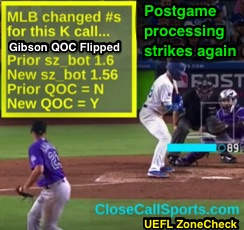To recap, Gibson tossed Roberts following a 2-0 pitch ruled a strike that passed over the center of home plate and vertically near the hollow of LA batter Gavin Lux's knee.
At the time, the computer (that'd be TrackMan near what could become the final phase of its Major League Baseball existence) deemed the pitch an unequivocal ball, low: sz_bot 1.6 and pz 1.35. Accounting for margin-of-error, the pitch was less than half an inch away from borderline "call stands" territory: QOC = Incorrect. In fact, the preceding ball call was located higher off the ground than the subsequent strike (ball: pz 1.41, strike: pz 1.35).
Related Post: MLB Ejection 212 - Greg Gibson (2; Dave Roberts) (9/20/19).
 |
| Watch out for inaccurate real-time FoxTrax. |
For Gavin Lux in the 4th inning, the numbers were changed thusly: sz_bot for the ball call increased to 1.69 ft, while sz_bot for the strike call decreased to 1.56 ft—a difference of 0.13 feet, or 1.56 inches.
 |
| The vertical phenomena happened before, too. |
Lessons: The robot umpire concept simply doesn't work if we have to wait for overnight processing to conclude before knowing whether a given pitch was a ball or a strike. It's not good enough to have an automated system call "strike three," only to find out several hours later that, "sorry, it should have been ball four."
Second, this isn't even the first time this season that postgame processing has exposed the vertical strike zone blind spot of the pitch-tracking computer. Earlier in 2019, it happened to Ron Kulpa in Houston, it happened to Ramon DeJesus in Minnesota, it happened to Jeremie Rehak in Anaheim, and now it has happened to Greg Gibson in LA. All four times, it took until the next day for the umpire to be vindicated by revised pitch tracking numbers.
Related Post: MLB Ejections 130-131 - Ramon De Jesus (1-2; MIN) (7/23/19).
Related Post: MLB Ejection 077 - Jeremie Rehak (4; Brad Ausmus) (6/9/19).
Related Post: MLB Ejections 007-08 - Ron Kulpa (1-2; Cintron, Hinch) (4/3/19).
Third, post-game processing solely goes to work, generally, on sz_bot and sz_top, meaning it tackles the vertical zone problem but not other sources of error, including calibration or tracking. For instance, postgame processing does not account for the three-dimensional strike zone problem posed by a tracking system that sees things in two dimensions (at the front edge of home plate).
For more information about UEFL ZoneCheck and MLB's habitual vertical strike zone problem, see the following related articles.
Related Post: ZoneCheck - Twins' Ump De Jesus' Ball 4 Call (7/24/19).
Related Post: Bad Computer Umpire - Faulty Pitch Data Defames Kulpa (4/6/19).
Video as follows:
Alternate Link: Postgame Processing Strikes Again - Greg Gibson's Ejection Revisited (CCS)











0 comments :
Post a Comment